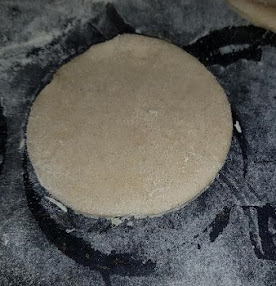Original Recipe
Take thick almond milke seething hot, and so wet your flower with it: and Sallet oyl fryed, and Saffron, and so mingle your past altogether, and that will make good paste The good Huswifes Handmaide for the Kitchin, London 1594, 1597
This is an interesting recipe as it addresses an issue with pastry that isn’t often considered – how do you make pastry in lent when eggs and butter are forbidden. There are a large number of pies and pasties that are specifically Lenten recipes through the middle ages, however, how do you make the pastry acceptable?
The basic pastries of the 14th century that used only water would not have been an issue during Lent, but more complex butter and egg pasties would have been forbidden.
The above recipe is perhaps a way they got around the strictures.
The date is also interesting, it come from a collections recipes published in London at the very end of the 16th century and at a time when England’s view of itself as a protestant nation was firmly established and perhaps the holding of a strict Lent would have been on the wane. The need for a recipe for a Lenten pastry shows that for some (at least) it is still important enough to need a solution.
Breaking down the recipe.
The recipe is very vague in it is instructions with no indications of proportions or quantities. It does say it is for a "short" pastry. A classic modern short pastry is 2 parts flour to 1 part fat. However, the same principle cannot be applied to this recipe due to the level of liquid involved in both the almond milk and oil. I tried 2 different versions of this pastry using different proportions.
Version 1
I heated the almond milk to just below boiling point, to get it to "seething hot". In a separate pan I heated the oil and saffron. When the milk was hot, I poured it in to the flour and mixed two together. I then added the oil to bring the mixture together.
The texture was similar to a Hot Water Crust pastry, where you use butter / lard melted into water and then poured over the flour. I should also say it didn’t have the most appealing of smells, but that could just be me.
The pastry rolled out smoothly and easily cut very nicely.
Having made my pastry, I cooked it in 2 methods, frying and cooking in an oven as two of the most common methods for cooking pastry.
Frying
The pastry fried nicely and became fluffy.
The pastry tasted good with a light structure and it held up well under the heat of frying.
Baking
I then baked a batch in the oven 180C for 25 minutes.
The discs bake well and evenly and again came with the light texture I would expect from a short crust pastry.
Version 2 - Less almond milk and more oil
- 100ml almond milk
- 200g flour
- 100ml oil
- Saffron
As before I heated the almond milk and oil and combined them with the flour. The texture is (as you would expect) oilier but also more crumbly and as a result not as easy to use or roll out.
You can see from the photos the difference consistency in this second version.
This pictures shows how different the two pastries are. The left is the one with the greater oil and right is the one with the greater almond milk content.
As with the first version I cooked the pastry both by frying and by cooking
Frying
The pastry held up will under the heat and cooking evenly. However the oily texture was not helped by the additional oil in the frying. The taste was reasonable with an acceptable texture and could work for fried pastries.
The baking of the pastry had the effect of the drying out the pastry and had the texture more of cardboard. The taste whilst not unpleasant it failed to give the light "short" feel that I would expect from a short pastry.
Conclusion
Based on these two versions, we can draw a few conclusions:
It is very possible and very simple to make a tasty and effective short pastry using almond milk
Only a very small amount of oil is needed to bring the pastry together.
This recipe not only gives us an interesting example of pastry techniques in the 16th century but also gives a very useful vegan /dairy free pastry recipe. This I feel wold be a much better version to use than a manufactured soya butter / margarine.
Final Recipe - enough for 1 pie
- 300ml commercial unsweetened almond milk
- 300g plain flour
- 50ml of oil (light olive/veg oil)
- Pinch of saffron (optional)
- Pinch of salt
- If you would to use the saffron to give a light colour pre-soak your saffron in your oil.
- Heat the almond milk to just below boiling point - do not allow to boil over.
- In a separate pan gently heat the oil.
- In a large mixing bowl add the flour and salt and then pour in the almond milk, and mix quickly with a wooden spoon. Add enough of the oil to bring the mixture together in to a smooth paste.












No comments:
Post a Comment